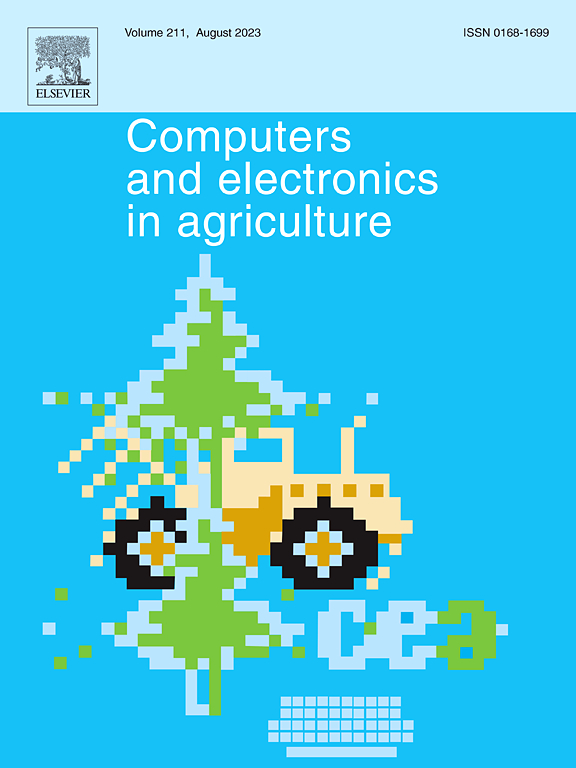A variable-rate spraying method fusing canopy volume and disease detection to reduce pesticide dosage
IF 8.9
1区 农林科学
Q1 AGRICULTURE, MULTIDISCIPLINARY
引用次数: 0
Abstract
Variable-rate spraying technology based on plant canopy volume is widely applied during precision agricultural practices. However, field observations indicate that larger canopies typically correlate with healthier trees, exhibiting reduced disease risk and severity. Therefore, the integration of canopy health information into variable-rate pesticide application is imperative. This study developed a variable-rate spraying system that addresses the critical limitations of conventional variable-rate spraying systems by employing a multisensory fusion methodology, which integrates real-time spot detection with plant canopy volumetry. Dual-modality sensing system achieves concurrent canopy volume measurement (4.34% error) and spot detection (82.6% accuracy), enabling adaptive pesticide dosage optimization through integrated decision-making that synergizes disease severity with canopy volumetry. Experimental tests demonstrated a 74.0% reduction in chemical usage compared to conventional spraying, while maintaining the required deposition parameters for low-severity diseases, and a 42.7% reduction for high-severity diseases. When targeting pear rust disease, the system attained 86.53% control efficacy with 66.4% and 22.2% dosage savings over traditional and volume-only variable-rate spraying approaches, respectively. The newly developed variable-rate spraying system can perform as a precise variable-rate spraying system using fused information on fruit-tree canopy volumes and disease, which significantly reduces the use of pesticides without affecting the control effect, further enabling a reduction in pesticide quantity and an increase in efficiency.
一种融合冠层体积和病害检测的变率喷洒方法,以减少农药用量
基于植物冠层体积的变速率喷雾技术在精准农业实践中得到了广泛应用。然而,实地观察表明,较大的冠层通常与较健康的树木相关,表现出较低的疾病风险和严重程度。因此,将林冠健康信息整合到变剂量农药应用中是势在必行的。本研究开发了一种可变速率喷洒系统,通过采用多感官融合方法,将实时斑点检测与植物冠层体积测量相结合,解决了传统可变速率喷洒系统的关键局限性。双模态感知系统实现了冠层体积测量(误差4.34%)和现场检测(精度82.6%)同步进行,通过综合决策实现了疾病严重程度与冠层体积测量协同的自适应农药用量优化。实验测试表明,与传统喷洒相比,化学品使用量减少了74.0%,同时对低严重疾病保持所需的沉积参数,对高严重疾病减少了42.7%。在防治梨锈病时,该系统的防治效果为86.53%,比传统和单量可变剂量喷洒分别节约66.4%和22.2%的用量。新开发的变速喷洒系统可以作为一种融合了果树冠层体积和病害信息的精确变速喷洒系统,在不影响防治效果的情况下,显著减少了农药的使用,进一步减少了农药用量,提高了效率。
本文章由计算机程序翻译,如有差异,请以英文原文为准。
求助全文
约1分钟内获得全文
求助全文
来源期刊

Computers and Electronics in Agriculture
工程技术-计算机:跨学科应用
CiteScore
15.30
自引率
14.50%
发文量
800
审稿时长
62 days
期刊介绍:
Computers and Electronics in Agriculture provides international coverage of advancements in computer hardware, software, electronic instrumentation, and control systems applied to agricultural challenges. Encompassing agronomy, horticulture, forestry, aquaculture, and animal farming, the journal publishes original papers, reviews, and applications notes. It explores the use of computers and electronics in plant or animal agricultural production, covering topics like agricultural soils, water, pests, controlled environments, and waste. The scope extends to on-farm post-harvest operations and relevant technologies, including artificial intelligence, sensors, machine vision, robotics, networking, and simulation modeling. Its companion journal, Smart Agricultural Technology, continues the focus on smart applications in production agriculture.
 求助内容:
求助内容: 应助结果提醒方式:
应助结果提醒方式:


